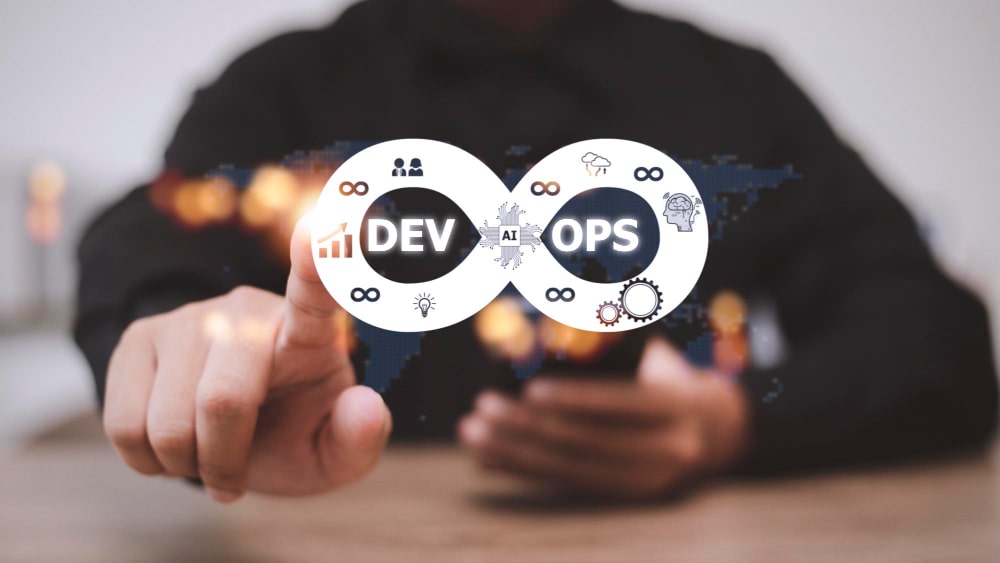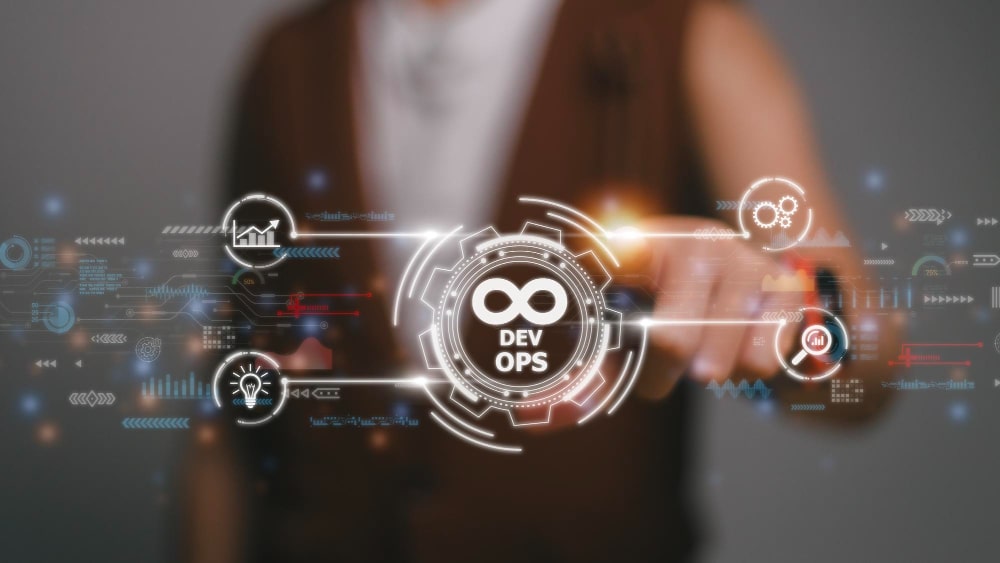Ensuring reliable, efficient, and secure operations is crucial in the competitive world of software development. Our DevOps services address the unique challenges software product companies face. These are designed to help you achieve continuous integration, delivery, and deployment, while maintaining high security and operational excellence.
Leverage our DevOps consulting services to accelerate the time-to-market of your software. We cater to complete DevOps assessment, DevOps automation, and DevOps management.
We automate your software integration and deployment processes with CI/CD. This means faster, more reliable releases and a more efficient development pipeline.
Implement robust automated testing directly into your development process, enabling faster bug detection, ensuring code quality, and ultimately delivering better software with every release.
Streamline your system and application configurations, automating the process to ensure consistency and minimize errors. Keep your team agile, and offer a smoother, more reliable experience to your users.
Define and manage your infrastructure as code (IaC), ensuring consistent and reproducible setups every time. It increases agility, reduces errors, and speeds up your deployment process.
PixelCrayons offers DevOps as a service and has experts to provide comprehensive DevOps software development services like planning and strategy execution.
Leverage the power of Docker, Kubernetes, and other tools to create, manage, and scale your applications using containers. Enjoy more portability, efficiency, and security for your software.
Implement comprehensive monitoring and logging solutions for deep visibility into your systems. You’ll be able to identify and diagnose issues effectively, leading to quicker resolutions and improved system stability.
Develop and implement robust disaster recovery plans to keep your business running, even in the face of unexpected failures. We keep you prepared with minimal downtime and operational continuity.
Integrate security into every stage of the DevOps process, from planning to monitoring. We ensure that your software meets the highest standards of quality, compliance, and protection.
Regularly review and optimize your infrastructure costs, ensuring you get the most out of your resources. You’ll benefit from greater efficiency and potential cost savings without sacrificing performance.
Our DevOps solutions are tailored to address the unique challenges faced by software product companies, providing you with the tools and expertise needed to streamline your operations and accelerate your development cycles.
Don’t let security and operational challenges hold you back. Choose a package that fits your needs and get started today. With our 30-day money-back guarantee, there’s no risk.

In the competitive software development landscape, ensuring smooth, reliable, and secure operations is essential.
Our comprehensive DevOps services are designed to help you achieve continuous integration, delivery, and deployment, while maintaining high security and operational excellence.
We can help you speed up your software release process with our DevOps automation services.
Regardless of your business size or sector, our software engineering expertise is designed to elevate your operations.






Tailoring the Approach to Your Needs

Embrace the culture of collaboration and continuous improvement with DevOps. Our approach integrates development and operations for faster delivery, higher software quality, and more reliable releases, enhancing responsiveness to market changes.

Adopt a flexible and efficient development approach with Agile. Our Agile methodology promotes adaptive planning, evolutionary development, early delivery, and continual improvement, encouraging rapid and flexible response to change.

Implement Scrum for a more structured yet flexible development process. This iterative approach divides development into sprints, focusing on delivering specific features within a set timeframe, fostering teamwork, accountability, and iterative progress.

Choose Waterfall for its sequential, linear approach to software development. Ideal for projects with well-defined requirements and scope, our Waterfall methodology emphasizes meticulous planning, documentation, and stage-wise progression for a structured and disciplined delivery.
We specialize in engineering custom software that's both stable and secure, using a variety of tech tools.
Defining goals and planning for a successful software project.
Creating intuitive design and robust architecture for user engagement.
Building and rigorously testing for reliable, secure software performance.
Launching software smoothly in live environments with minimal downtime.
Delivering software with ongoing support and future enhancements available.
Our team of DevOps consultants holds relevant knowledge about the following core technologies:

With us, you can choose from multiple hiring models that best suit your needs.

Hire an autonomous expert team that, consists of Software Engineers, Quality Analysts, Project Managers and other professionals to deliver efficient and timely technology solutions. Job roles and responsibilities of our experts are discreetly defined for each project, and management is jointly handled by a Scrum Manager and the client’s product owner.

Our team augmentation model allows you to select the right set of talent and experience helping you fill the talent gap in your team. The augmented team works as part of your local or distributed team, attends daily meetings, and directly reports to your managers. This hiring model is suitable for businesses and projects of all sizes.

It is obtained when the project specifications, scope, deliverables, and acceptance criteria are clearly defined, enabling us to evaluate and frame a fixed quote for the project. It best suits the small-mid scale projects having well-documented specifications.
Time & Material Model:It best suits projects with a dynamic scope or complicated business requirements, hindering accurate cost estimation. You pay for the services according to the time spent on the project and get an opportunity to realise the optimum benefits.
Here is our complete guide on DevOps that you can consider for your next big project. This will help you learn about the process, get detailed information, and choose the right team for you.

There are many reasons why companies need DevOps. It is a set of practices that helps organizations improve communication and collaboration between development and operations teams.
DevOps also helps organizations automate the software delivery process to deliver software faster and more efficiently. In addition, DevOps can help organizations reduce costs, improve quality, and increase customer satisfaction.
Some of the benefits of DevOps include:
Faster software delivery: DevOps helps organizations speed up the software delivery process by automating tasks and improving communication and collaboration between development and operations teams.
Improved quality: DevOps can help organizations improve the quality of their software products by automatically testing code changes and deployments.
Increased customer satisfaction: DevOps can help organizations improve customer satisfaction by delivering software faster and more efficiently.
Reduced costs: DevOps can help organizations reduce costs by automating tasks and improving the efficiency of the software delivery process.
If you are considering implementing DevOps in your organization, you should consider hiring a DevOps consultant or a DevOps solutions company. These professionals can help you implement DevOps practices and tools in your organization to achieve the benefits of DevOps.
There are many factors to consider when choosing a DevOps development services provider. Here are some key factors to keep in mind:
1. Comprehensive Services: Ensure your chosen DevOps solutions company offers comprehensive DevOps development services. This way, you can be confident they can support your organization through every stage of your DevOps journey.
2. Proven Experience: Choose a DevOps consulting company with a proven track record of success in helping organizations implement DevOps. It will give you confidence that they know what they’re doing and can help you avoid common pitfalls.
3. Flexible Pricing: You should have flexible pricing options to get the needed services without breaking the bank.
4. Supportive Community: Choose a company that is part of a supportive community of DevOps practitioners. Tap into a wealth of knowledge and experience to help and succeed with your own implementation.
5. Personalized Approach: Make sure your chosen company takes a personalized approach to help you implement DevOps. A personalized approach will ensure they tailor their services to meet your needs and requirements.

The DevOps life cycle typically consists of the following six phases:
1. Planning and Development: The DevOps development services team plans the overall DevOps strategy and approach. They also identify the tools and technologies that will be used in the implementation.
2. Continuous Integration: In the second phase of the DevOps lifecycle, code changes are regularly integrated into a shared repository. Continuous integration helps to avoid conflicts and makes it easier to track progress.
3. Continuous Delivery: Software changes are automatically built, tested, and deployed to a staging environment. This step ensures that changes can be rapidly delivered to users with minimal risk.
4. Continuous Testing: Automated tests are run on every code change to verify the correctness of the changes. Testing prevents regressions and ensures that only high-quality code is deployed.
5. Continuous Monitoring: The system is constantly monitored for performance and stability issues. It helps identify and fix problems before they impact users.
6. Feedback Loop: In this phase, user feedback continuously improves the system. Feedback loops help ensure that the system evolves to meet users’ needs.
Each of these phases is important in its own right, but together, they form a complete DevOps life cycle. By following this cycle, organizations can avoid many pitfalls that often arise during software development projects.
The DevOps model is a set of principles and practices that enable the continuous delivery of value to end-users through the rapid, iterative delivery of quality software.
At its core, DevOps automates and monitors the entire software development and delivery process, from code development to production deployment. By doing so, organizations can reduce the time it takes to deliver new features and updates while increasing the quality and stability of their software products.
DevOps requires close collaboration and communication between development and operations teams to achieve these objectives. Furthermore, it relies on tools and technologies that enable automation at every software development life cycle stage.
Some standard DevOps tools include configuration management tools, such as Puppet and Chef; continuous integration and delivery (CI/CD) tools, such as Jenkins and Travis CI; and container orchestration tools, such as Docker Swarm and Kubernetes.
While the DevOps model can be applied to any organization, it is particularly well suited for organizations looking to increase their agility and speed of delivery.
For these organizations, DevOps can help them to rapidly respond to changes in the market and customer demands while also ensuring that their software products are of high quality. In addition,
DevOps can also help improve organizational collaboration and communication, as well as reduce the silos that often exist between development and operations teams.

The key components of DevOps are the following:
1. Continuous Integration (CI): This software development practice encourages developers to integrate their work into a shared code repository. By doing this, developers can detect and fix problems early, which reduces the likelihood of major defects being introduced into the codebase late in the development process.
2. Continuous Delivery: This is the practice of automating software’s build, testing, and deployment to release it to production anytime. With the CD in place, developers can push new features and updates to production as often as desired without requiring manual intervention from operations staff.
3. Continuous Deployment: This is a variation of CD in which new code changes are automatically deployed to production without requiring manual approval. This practice requires that the codebase is in a constant state of deployable quality so that any new change can go live immediately.
4. DevOps Toolchain: The set of tools used to support the DevOps practices of CI/CD/CD. Some common tools used in DevOps toolchains include configuration management tools, such as Puppet and Chef; containerization tools, such as Docker and Kubernetes; and Continuous Integration/Continuous Delivery (CI/CD) tools, such as Jenkins and Bamboo.
5. Infrastructure as Code (IaC): This is the practice of provisioning and managing infrastructure using code rather than manual processes. This allows infrastructure to be treated like any other software asset, making it easier to manage and automate.
6. Microservices: This is an architectural style in which an extensive application is built as a set of small, independent services communicating with each other over a network. This approach to application development is well-suited to DevOps because it allows for easy and independent deployment of services.
7. DevOps culture: This is the set of values, beliefs, and behaviors that DevOps engineering services providers share. Some key attributes of a DevOps culture include a focus on collaboration, continuous learning, and a willingness to experiment.
DevOps and cloud computing go hand in hand. Cloud platforms like AWS, Azure, or Google Cloud provide infrastructure scalability, flexibility, and automation capabilities that align well with DevOps practices.
DevOps in cloud environments involves leveraging cloud-native technologies, serverless architectures, and infrastructure automation tools to streamline development, deployment, and scaling processes.
DevOps and Agile methodologies like Scrum or Kanban complement each other. DevOps emphasizes collaboration, automation, and continuous improvement, aligning well with Agile principles.
Teams can integrate DevOps practices into Agile workflows by incorporating CI/CD pipelines, automated testing, and collaboration tools for enhanced productivity and faster delivery.
Delivering new features and updates quickly and reliably is essential for staying ahead in today’s fast-paced software development landscape.
CI/CD helps you automate the process of integrating code changes, running tests, and deploying applications to production environments.
Instead of manual deployments and lengthy testing cycles, CI/CD pipelines streamline the entire software release process. Developers can integrate their code changes frequently into a shared repository, where automated tests verify the code’s correctness.
Once the code passes these tests, it can be automatically deployed to staging or production environments.
This automated approach brings numerous benefits, including:
Faster Time-to-Market: Automating the release process means new features and bug fixes reach users faster, giving businesses a competitive edge.
Reduced Risk: Automated testing and deployments minimize the potential for human error, leading to more reliable releases.
Increased Efficiency: CI/CD frees up development and operations teams from manual tasks, allowing them to focus on higher-value activities.
Automated testing plays a crucial role in achieving quality and stability by providing a safety net for developers and accelerating the release process. But what exactly does automated testing involve?
Essentially, it’s about using tools and scripts to execute tests on software applications automatically. Instead of manually checking for bugs and functionality issues, it gives you pre-defined tests that run every time the code changes.
The advantages of automated testing lie in its ability to:
Identify Bugs Early: Automated tests act as a first line of defense, catching bugs and errors early in the development cycle before they escalate into major issues.
Ensure Consistent Quality: By running the same tests every time the code is updated, you ensure consistent quality and prevent regressions.
Speed Up Development Cycles: Automated tests provide rapid feedback to developers, allowing them to iterate and make changes more efficiently.
Configuration Management (CM) prevents inconsistent configurations. It ensures that all your environments – development, testing, staging, and production – are configured identically and automatically. No more manual tweaks, no more “it works on my machine” dilemmas.
Here’s how CM benefits your business:
Eliminates Configuration Drift: Over time, systems naturally deviate from their intended configurations (that’s configuration drift). CM tools automate configuration updates, keeping everything aligned.
Reduces Errors: Manual configurations are prone to human error. Automation minimizes these risks, leading to more stable and reliable systems.
Faster Deployments: With consistent environments, deployments become smoother and faster, enabling you to deliver value to your users more quickly.
Simplified Disaster Recovery: CM makes it easier to rebuild and recover systems after a failure, as you have a standardized configuration to work from.
Disasters, whether natural or man-made, can strike any business at any time. From cyberattacks and hardware failures to fires and floods, the potential for disruption is significant. That’s why a robust Disaster Recovery Plan (DRP) is essential for business survival.
A DRP outlines the steps your organization will take to recover critical data and applications in the event of a disaster. It’s about minimizing downtime, mitigating data loss, and ensuring business continuity even when facing unexpected challenges.
Here’s why you can’t afford to ignore disaster recovery planning:
Minimizes Downtime: Every minute your business is offline translates to lost revenue and productivity. A DRP helps you get back up and running quickly, minimizing the impact on your operations.
Protects Your Reputation: Downtime can damage your brand’s reputation and erode customer trust. A solid DRP demonstrates your commitment to business continuity and customer satisfaction.
Ensures Compliance: Many industries have regulatory requirements regarding data protection and disaster recovery. A DRP helps you meet these obligations and avoid costly penalties.
Gain industry insights and learn from our proven track record with our latest blogs and case studies.
The DevSecOps vs. DevOps debate has been one of the most hotly contested battles in today's software development, security, and…
Learn MoreThe term “Mobile application development” has become one of the most critical aspects for SMEs, Startups, and entrepreneurs in recent…
Learn MoreDo you know why DevOps is the most talked about technology trend? It's because of its ability to help businesses…
Learn MoreRecently, how we think about creating web applications has changed. We are now dividing our programs into smaller, more…
Learn MoreHere are some questions that our clients frequently ask. If you need more information or have any other questions, feel free to contact us.
We offer various services to help organizations implement DevOps practices and achieve their business goals. These DevOps services include:
Clients working with PixelCrayons, a leading DevOps services and solutions company, are guaranteed satisfactory results as we follow the DevOps & agile approach, offer different engagement models, and sign strict NDA.
We are among India’s leading DevOps engineering services providers with a vast experience of serving 5400+ customers with utmost satisfaction.
Our DevOps solutions company boasts talents with an average of five years of experience. Our tech enthusiasts have handled many complex projects in their careers.
Our DevOps services and solutions costs vary based on the scope and complexity of your project. Contact us today for a personalized quote for DevOps services.
Yes. We provide a quote based on your unique requirements and desired service levels that you can further customize to your specific needs.
We apply security patches based on your package – monthly (Starter), bi-weekly (Business), or weekly (Enterprise). It helps keep your systems remain secure against the latest threats.
Yes, microservices support is available in the Enterprise and Custom packages. We help you manage complex architectures by using containers and orchestration tools like Kubernetes.
Depending on your package, we offer guidance for Starter, direct implementation for Business, and advanced strategies for Enterprise to keep your services accessible.
We regularly check your cloud usage and costs to ensure maximum efficiency and cost-effectiveness. This includes adjusting resources, optimizing workloads, and finding ways to cut costs.
Yes, we take care of your servers, from basic (Starter) to priority (Enterprise) levels. We ensure your servers remain updated, secure, and running at their best.
DevOps is different from just about any other approach known to date. DevOps involves a focus on collaboration between development and operations. Many core principles apply Developer Practices, Continuous Integration (CI), Layer-by-Layer Security, Incident Response, Microservices Architecture, Peer Reviews, Release Automation & Management, and Service Level Agreements (SLAs).

Software development costs vary widely, starting from $30K to $150K+ for a moderately complex mobile app, and soaring up to $800K to $4M for extensive systems integrated with big data and AI technologies.
Let us show you how our digital services can drive your success.